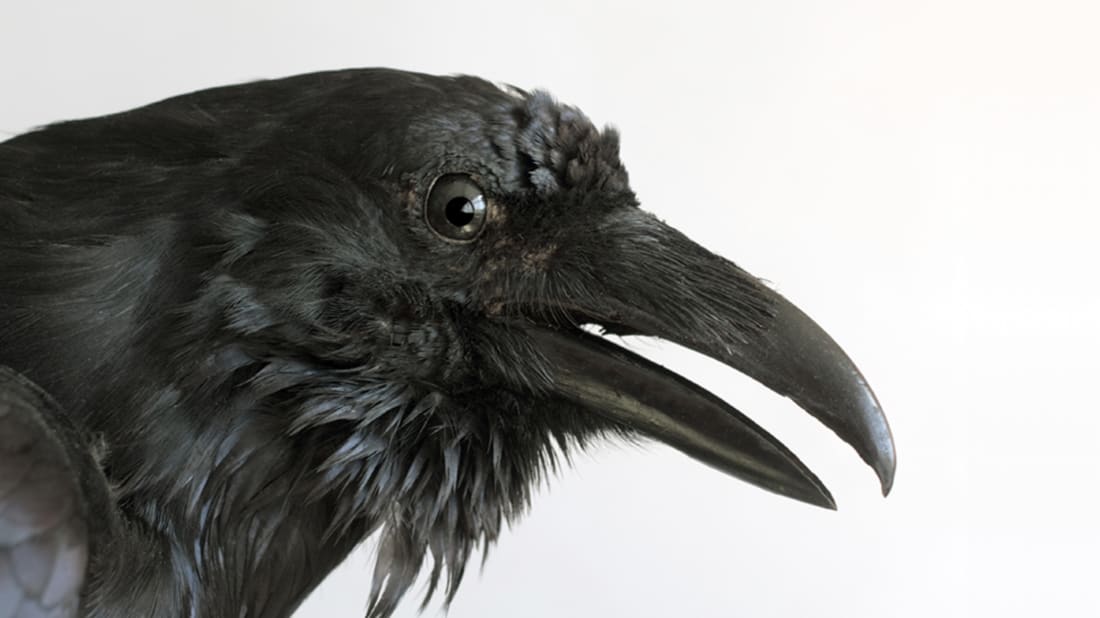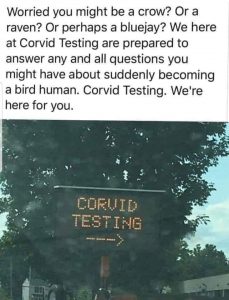 Tonight’s post came together because a friend of mine re-posted a joke about a random sign typo (“CORVID TESTING”) on Facebook (image to the right). Not content to simply laugh and move on, I felt compelled to respond with:
Tonight’s post came together because a friend of mine re-posted a joke about a random sign typo (“CORVID TESTING”) on Facebook (image to the right). Not content to simply laugh and move on, I felt compelled to respond with:
If you have (or suspect that you have) contracted CORVID, you can’t get together in groups. So no murder of crows, unkindness of ravens, scold of jays, or parliament of magpies. [Admit it, the group names for corvids are the absolute best. They’re supposed to be the titles of my first four novels. I’m way behind plan.]
That’s when my brain decided that it was important that I assemble a collection of cool facts about Corvids, because they have fascinated me since I was a child.
Stress-busting tip: if you’re sitting there fussing over something, try reading some poetry. And when I say reading, I mean that I literally want you to sound the words out loud. Preferably while standing. There is something about doing this that interrupts some of those negative patterns rattling around in your skull. And on that note, I’m going to do the obvious, and provide you a link to Edgar Allen Poe’s The Raven over at The Poetry Foundation, where I have more stuff bookmarked than I care to admit. Let me know if this trick works for you.
What’s a Corvid, you say?
Corvidae is a family of passerine (big, fancy word meaning feet that are adapted for perching) birds that contains the crows, ravens, rooks, jackdaws, jays, magpies, treepies, choughs (pronounced “chuff”, because English is weird), and nutcrackers (pronounced “nutcrackers”, because English is weird). In common English, they are known as the crow family, or, more technically, corvids.
21 Cool Facts About Corvids (or, put another way, CORVID-21)
-
Corvids have absolutely fantastic group names. A murder of crows, an unkindness of ravens, a scold of jays, or a parliament of magpies… if corvids are cool on their own, they only get better in the plural!
-
Ravens are really intelligent. In one logic test, the raven had to get a hanging piece of food by pulling up a bit of the string, anchoring it with its claw, and repeating until the food was in reach. Many ravens got the food on the first try, some within 30 seconds. In the wild, ravens have pushed rocks on people to keep them from climbing to their nests, stolen fish by pulling a fishermen’s line out of ice holes, and played dead beside a beaver carcass to scare other ravens away from a delicious feast. If a raven knows another raven is watching it hide its food, it will pretend to put the food in one place while really hiding it in another. Since the other ravens are smart too, this only works sometimes.
-
Ravens can imitate human speech. They have a vast repertoire of 100 or more vocalizations. In captivity, ravens can learn to talk better than some parrots. They also mimic other noises, like car engines, toilets flushing, and animal and birdcalls. Ravens have been known to imitate wolves or foxes to attract them to carcasses that the raven isn’t capable of breaking open. When the wolf is done eating, the raven gets the leftovers.
-
Ravens are playful creatures. Ravens are acrobats in the sky. They surf updrafts, fly upside down and even turn somersaults, just because they can. Young ravens have been seen playing a fun game of catch by dropping sticks while in flight and then quickly swooping to catch it before it hits the ground. They have been observed in Alaska and Canada using snow-covered roofs as slides. In Maine, they have been seen rolling down snowy hills. They often play keep-away with other animals like wolves, otters, and dogs. Ravens even make toys—a rare animal behavior—by using sticks, pinecones, golf balls, or rocks to play with each other or by themselves. And sometimes they just taunt or mock other creatures because it’s funny.
- Ravens do weird things with ants. They lie in anthills and roll around so the ants swarm on them, or they chew the ants up and rub their guts on their feathers. The scientific name for this is called “anting.” Songbirds, crows, and jays do it too. The behavior is not well understood; theories range from the ants acting as an insecticide and fungicide for the bird to ant secretion soothing a molting bird’s skin to the whole performance being a mild addiction. Birds who engage in anting appear to be in total bliss and high as a kite.
-
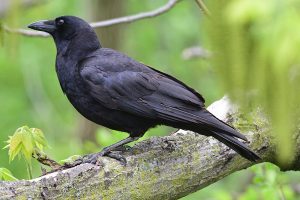
The American crow will remember your actions, so mind your manners!
Crows get chick-rearing help from the older kids. Juvenile birds are frequently seen defending their parents’ nest from predators. Other services they can provide include bringing food to mom and dad, or feeding their younger siblings directly. One study found that 80 percent of American crow nests surveyed had a helping hand. And some birds become regular nest assistants, providing aid to their parents for over half a decade.
-
When a crow dies, its neighbours may have a funeral. The sight of a dead crow can attract a mob of a hundred or more live ones. During this ritual, the live crows almost never touch the dead one, which rules scavenging out as a motive. Why do they do this? Some studies suggest that the mass gathering is part of a survival strategy: The birds are learning about threats and seem hesitant to revisit any spot where they’ve encountered a dead crow, even if food is plentiful there.
-
Some crows can read traffic lights. In Japan, carrion crows (Corvus corone) use cars like oversized nutcrackers. The birds have learned to take walnuts—a favorite treat—over to road intersections, where they put the hard-shelled snacks down onto the pavement. The crow then waits for a passing vehicle to smash the nut, after which it will swoop down and eat the delicious interior. It’s a risky trick, but the crows aren’t usually run over because (unlike some people) they’ve figured out what traffic lights mean. Carrion crows wait until the light turns red before flying down to place the un-cracked nut on the road. The second the light goes green, the crow takes off to watch the nut get run over from afar; it will even wait for the next red to scoop up the nut’s insides. This behavior isn’t limited to just one corvid species: American crows have been observed doing the same thing in California.
-
Crows can recognize your face and hold a grudge. In 2011, a team from the University of Washington published a remarkable study establishing how well the birds could identify human faces. The used a caveman mask and one that looked like Dick Cheney. They used people wearing the caveman mask to threaten the birds, capture them, and band them and the Cheney mask was a neutral human being just passing through their territory. Over a period of several years, both masks were regularly worn by team members on strolls through all five test spots. Without fail, the caveman mask was greeted by angry scolds and dive-bomb attacks from crows—including many who’d never been captured or banded—while the birds largely ignored the Dick Cheney mask. Five years later, some of the birds who antagonized the mask-wearer weren’t even alive back when the whole thing started. The younger crows couldn’t possibly have seen the imitation caveman grab an acquaintance of theirs—but they scolded it anyway. The moral of this story? Mind your manners around crows. Because if you mistreat them, they won’t forget you and neither will their friends—or the next generation.
-
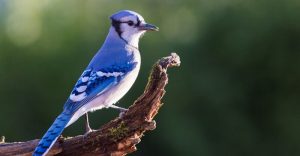
It’s a blue jay, but it’s not blue. Does your head hurt yet?
Blue jays are not blue. It’s true! While they appear blue, it is just a trick of the light. A Northern Cardinal is red because its feathers are red pigment. Blue Jays have no such blue pigment. If you crush the wing of a cardinal into a powder, it will be red. If you do the same with a blue jay feather, the powder will be brown. This magic is a result of light scattering. When visible light strikes the feathers, all colours except blue pass through. The blue coloured light is reflected, and so your eyes see blue. If you wet the blue jay wing, it interrupts this scattering effect, and you see it as brown.
-
Blue jays live a long time. Most wild birds live between 5 and 7 years, but the oldest known wild blue jay was at least 26 years and 11 months old, banded in Newfoundland in 1989, and found dead in 2016.
-
Blue jays might be pretty, but they sure are slow! They typically fly around 32 to 40 kilometres per hour. Compare this to ducks, which can fly 96 kilometres. A falcon can reach top speeds of 321 kilometres per hour. Their leisurely flight patters make jays easy prey for hawks, owls, and falcons. This is why they are typically highly aware of other birds in their vicinity and can explain why they have a hawk alarm system.
-
Blue jays have a hawk alarm system. They warn birds (and mammals, too) when a hawk is approaching. This wasn’t clever enough, so they learned to imitate the sound of hawks and use it when there are no hawks around to scare other birds away from the feeder so they can get it all to themselves.
-
Blue jays are smart parents. Both male and females build the nest and rear the young. Contrast this with the lazy parenting style of brown-headed cowbirds, preferring to sneak their eggs into other birds’ nests for the foster parents to raise. Most of the time this works, which explains some very frustrated robin parents. Blue jays, however, see right through this trick and treat the cowbird eggs as a wonderful form of UberEats, and eat the warm cowbird eggs hiding amongst their own eggs.
-
Blue jay migration patterns are confusing. Some years, they decide to stay in one place year round. Then, out of the blue, they decide to pack their bags the next fall and head south for the winter. Why stay for years on end and then suddenly pick up and leave for no apparent reason, only to return the next spring? We don’t know. We think it has something to do with changes in food source abundance, but we can’t prove it.
-
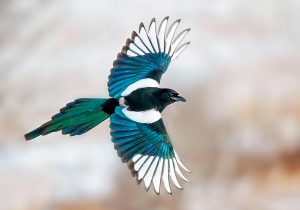
First the French, then the Italians, smeared its character, but the Eurasian magpie sure is pretty
Eurasian magpies don’t actually like shiny objects. In 1815, two French playwrights wrote La Pie Voleuse where a servant is sentenced to death for stealing silverware from her master, when the real thief is his pet magpie. The story was then picked up by Gioachino Rossini , who wrote his opera La gazza ladra to the same story. This character assassination has persisted to today, making it weird to realize that a bird that with the reputation as a thief who wants nothing more than to steal your shiny jewelry or ornaments from your garden, has actually been demonstrated by research to be somewhere between indifferent to repelled by shiny objects. Huh.
-
Eurasian magpies rotate back and forth between vegetarian and carnivorous periods. In the winter, their diet is primarily vegetarian. In the spring, the magpie becomes a major predator, raiding the nests of songbirds for eggs and young. Then in the summer, it switches to diet focused on ground invertebrates.
-
Eurasian magpies have some interesting courtship behaviours. A male magpie, when out on his own, may become attracted to a single female, attempting to court and mate with her. If, however, he’s out on the wing with his own mate, they will act as a team and attack the single female, trying to drive her away.
-
The latin name for the Eurasian magpie is Pica pica. If you’re not already smiling, you probably don’t have children after 1996, and you have not been subjected to the distinct cry of the Pikachu species of Pokémon.
-
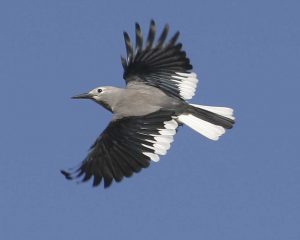
The Clark’s nutcracker can remember more things than I can.
The Clark’s nutcracker is a world-class prepper. They have a special pouch under the tongue to carry 30 to 150 seed, which it then caches away in hiding spots for later use. A single bird can collect and store up to 98,000 seeds per year.
-
Fortunately the Clark’s nutcracker has excellent memory. It would have been a shame to hide that many seeds, only to be unable to find them all later (like the grey squirrels in my yard). It can find almost all hidden seed 6 to 9 months from the moment of storing. Many species of pines have evolved (changed the shape of the tree and cones) to facilitate extraction of seed and their dispersal in the wild by Clark’s nutcrackers.
This concludes Kirsten’s random tour of cool facts about Corvids. I threw out more than I kept, trying to keep the list to just 21 facts, all in the name of a fairly lame pun title.
Merely this and nothing more.

